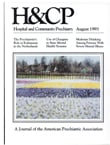Compliance With Clinic Attendance by Outpatients With Schizophrenia
Abstract
Objective: The purposes of the study were to determine rates of compliance with appointments among patients with schizophrenia who had been treated for more than four years in an outpatient clinic, to explore reasons for missed appointments, and to determine whether treatment modalities affected compliance rates. Methods: Chi square analysis was used to compare attendance rates over a 12-month period of 55 patients who were nonrandomly assigned to a monthly group and 56 patients who were nonrandomly assigned to be seen in individual treatment every one to two months. Patients were asked to give reasons for missed appointments. Results: From 71 to 86 percent of the patients kept their clinic appointments each month. Forgetting the appointment and transportation difficulties were the most common reasons for nonattendance. Compliance rates of patients in the two treatment modalities differed during only three of the 12 months: during two of those months subjects in individual treatment bad higher compliance rates than those in groups. Conclusions: The results suggest that treatment modality has little impact on compliance and that compliance may be increased by letter and phone prompts and by staff awareness of patients' problems such as transportation and finances.
Access content
To read the fulltext, please use one of the options below to sign in or purchase access.- Personal login
- Institutional Login
- Sign in via OpenAthens
- Register for access
-
Please login/register if you wish to pair your device and check access availability.
Not a subscriber?
PsychiatryOnline subscription options offer access to the DSM-5 library, books, journals, CME, and patient resources. This all-in-one virtual library provides psychiatrists and mental health professionals with key resources for diagnosis, treatment, research, and professional development.
Need more help? PsychiatryOnline Customer Service may be reached by emailing [email protected] or by calling 800-368-5777 (in the U.S.) or 703-907-7322 (outside the U.S.).



